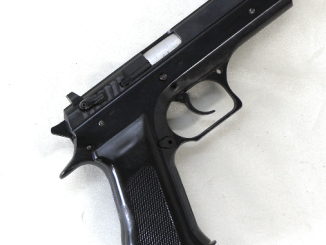Following its experience in the Russo-Turkish War, the Romanian Army was quite impressed by the Martini-Henry rifle in Turkish service. Unlike so many Western observers who were taken by the Winchester repeating rifles that actually didn’t make much battlefield impact, the Romanians recognized the all-around quality of the Martini. So after the war when looking to equip their own newly independent army, they went to Britain for Martinis. They were not able to get rifles made in Britain, but did purchase a license to make the rifle in .45 Gatling, which they took to a factory in Witten, in the German state of Wurtemburg. This factory was newly opened, run in part by Friedrich von Martini himself – so what better place to get Martini rifles?
An initial contract for 60,000 rifles and 8,000 carbines was accepted by the factory and delivered fairly quickly. When the Romanians came back for more guns the factory had gone bankrupt, however. Subsequent orders were instead made form OEWG Steyr in Austria. In total, Romania acquired about 145,000 Martini long rifles and between 12,000 and 18,000 carbines. They were replaced by the Model 1893 Mannlicher in the 1890s, and thus were never used as a front-line rifle in any major combat. They served in World War One in a secondary role only.
Thanks to the King Ferdinand I Military Museum for giving me access to these examples and to A.N.C.A. for coordinating the visit! If you are in Bucharest, make sure to stop in and visit the museum:
https://www.muzeulmilitar.ro/en/




“Western observers who were taken by the Winchester repeating rifles that actually didn’t make much battlefield impact”……..
“Romania acquired about 145,000
Martini long rifles and between 12,000 and 18,000 carbines. They were
replaced by the Model 1893 Mannlicher
in the 1890s, and thus were never
used as a front-line rifle in any
major combat.”
um what?
Much was made by foreign observers at the time of the use by Turkish troops defending a small fortification at the Battle of Plevna in 1877 armed with Winchester 1866 rifles in .44 Henry rimfire against an assault by Russian troops armed with single-shot Krnka 1869 15mm (.60 cal) lifting block (similar to Sniders) rifles, most Turkish troops then armed with Peabody-Martini rifles in .45 Turkish (similar to .45-60ish) in the first place, also superior to the Krnkas. In actuality, the lever-action Winchesters were too short-ranged, too fragile, and used in too-small quantities to make a huge difference, AND were difficult for troops to use lying down (lever-action guns have that drawback). Although effective in this one small instance, it was the Turkish Peabody-Martini that most impressed the Russians and others, such as the Romanians, and nobody adopted Winchester 1866s in pistol calibers as they were a ‘tempest in a teapot,’ an aberration that had one small bright spot in history and got relegated to being a footnote shortly thereafter. The actual BIG takeaway was the realisation that repeating rifles of some sort were going to become The THING, not that Winchesters per se were going to fill the bill.
Excellent post. One wearing of leering keyboard jockies fantasizing about Oooh! Winchesters pouring it to their Russia bogeyman.Yanks and facts are like vampires and garlic. Again, kudos.